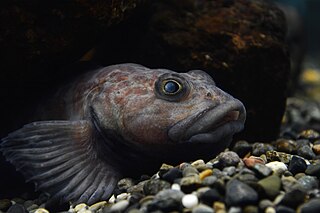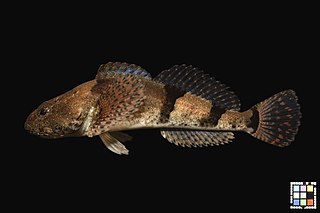
The Abyssocottinae are a subfamily of ray-finned fishes in the family Cottidae, the sculpins. They are known commonly as the deep-water sculpins. The entire subfamily is endemic to Lake Baikal in Siberia.
The Shoshone sculpin is a species of freshwater ray-finned fish belonging to the family Cottidae, the typical sculpins. It is It is endemic to the United States. It inhabits spring systems in the Thousand Springs formation near Hagerman, south-central Idaho. It reaches a maximum length of 9.0 cm. The specific name honors Charles Wilson Greene who was an instructor in physiology at Stanford University and was on the expedition on which the type was collected from the Thousand Springs on the Snake River, near mouth of Salmon Falls River in Gooding County, Idaho.
Cottus scaturigo, the Timavo sculpin, is a species of freshwater ray-finned fish belonging to the family Cottidae, the typical sculpins. It is endemic to the Timavo Spring in Italy. This species was described as a separate species from the European bullhead in 2005 by Jörg Freyhof, Maurice Kottelat and Arne W. Nolte. However, the Catalog of Fishes treats this taxon as a synonym of Cottus metae, although FishBase treats it as a separate species. The specific name scaturigo means "spouting water", i.e. a spring, an allusion to the Timavo Spring.

Abyssocottus is a genus of ray-finned fishes belonging to the family Cottidae, the typical sculpins. These sculpins are endemic to Lake Baikal in Russia.
Asprocottus is a genus of ray-finned fish belonging to the family Cottidae, the typical sculpins. These fishes are endemic to endemic to Lake Baikal in Russia.
Cyphocottus is a genus of ray-finned fish belonging to the family Cottidae, the typical sculpins. These fishes are endemic to endemic to Lake Baikal in Russia.
Limnocottus is a genus of ray-finned fish belonging to the family Cottidae, the typical sculpins. These fishes are endemic to Lake Baikal in Russia.
Procottus is a genus of ray-finned fish belonging to the family Cottidae, the typical sculpins. These fishes are endemic to Lake Baikal in Russia.
Bolinia is a monospecific genus of marine ray-finned fish belonging to the family Cottidae, the typical sculpins. This taxon is endemic to the northern Pacific Ocean around the Aleutian Islands of Amukta, Carlisle, and Semisopochnoi. It is found at depths of between 201 to 410 metres. This species grows to a length of 18.9 centimetres (7.4 in) SL. The only species in the genus is Bolinia euryptera.
Lepidobero is a monospecific genus of freshwater ray-finned fish belonging to the family Cottidae, the typical sculpins. Its only species is Lepidobero sinensis which is endemic to China.

Microcottus is a small genus of marine ray-finned fishes belonging to the family Cottidae, the typical sculpins. These fishes are found in the northern Pacific Ocean.
The spineless sculpin is a species of marine ray-finned fish belonging to the family Cottidae, the typical sculpins. This species is found in the Pacific Ocean where it is endemic to the waters around the Aleutian Islands, Alaska.
Batrachocottus is a genus of freshwater ray-finned fishes belonging to the family Cottidae, the typical sculpins. These fishes are endemic to the Lake Baikal watershed in Russia.

Cottocomephorus is a genus of freshwater ray-finned fishes belonging to the family Cottidae, the typical sculpins. This genus is endemic to Lake Baikal and its surrounding tributaries in Russia. They have relatively large pectoral fins and reach up to 22 cm in total length. They are an important food for the Baikal seal, during the winter second only to the golomyankas.
Neocottus thermalis is a species of ray-finned fish belonging to the family Cottidae, the typical sculpins. It was described by Valentina Grigorievna Sideleva in 2002. It is a freshwater, deep water-dwelling fish which is endemic to Lake Baikal, in Russia. It is known to dwell at a depth range of 430 to 480 metres.
Neocottus werestschagini is a species of ray-finned fish belonging to the family Cottidae, the typical sculpins. It was described by Dmitrii Nikolaevich Taliev in 1935, originally under the genus Abyssocottus. It is a rare freshwater, deep water-dwelling fish which is endemic to Lake Baikal, Russia. It dwells at a depth range of 877 to 1,400 metres, and inhabits silty sand sediments. Males can reach a maximum total length of 9.8 centimetres (3.9 in).
The black sculpin is a species of freshawater ray-finned fish belonging to the family Cottidae, the typical sculpins. It is endemic to the United States. Its range includes the extreme upper Clinch and Holston River systems in western Virginia and just into northeastern Tennessee. It reaches a maximum length of 8 cm (3.1 in).
Cottus dzungaricus is a species of freshwater ray-finned fish belonging to the family Cottidae, the typical sculpins. It is endemic to China. It reaches a maximum length of 10.0 cm. This species was first formally described in 2006 by the Belgian ichthyologist Maurice Kottelat a replacement name for Li & Ho's Cottus sibiricus altaicus of 1966, a name preoccupied by Cottus poecilopus altaicus which had been named by Nicholas Feofanovich Kaschenko in 1899. The type locality is Altai, northern Sinkiang in China. This species is distinguished from Cottus sibiricus by having a naked body whereas C. sibiricus is covered in prickles. The specific name dzungarius, means belonging to Dzungaria, northern Xinjiang where the species is found.
The Ozark sculpin is a species of ray-finned fish belonging to the family Cottidae, the typical sculpins. It is endemic to Missouri, United States. Inhabiting the Osage, Gasconade, and Black river drainages in Missouri. It reaches a maximum length of 14.0 cm. It prefers rocky riffles of headwaters and creeks.

The fourspine sculpin is a species of freshwater ray-finned fish belonging to the family Cottidae, the typical sculpins. It is endemic to Japan. It reaches a maximum length of 30.0 cm (11.8 in).




